Report on the Factors Contributing to Nokia's Market Share Loss
VerifiedAdded on 2020/04/15
|15
|3283
|319
Report
AI Summary
This report presents a comprehensive analysis of Nokia's significant loss of market share, transitioning from a mobile phone industry leader to a company acquired by Microsoft and later sold. The report delves into the various factors that contributed to this decline, including consumer behavior, such as the shift towards smartphones and the influence of cultural, social, personal, and psychological factors. It examines the impact of government regulatory and economic policies, as well as environmental factors, like technological advancements and raw material costs. Furthermore, the report assesses Nokia's responses to these challenges, highlighting its strategic missteps, such as the underestimation of software significance and the failure to adapt to changing market trends. The report concludes with recommendations for future business strategies and emphasizes the importance of understanding market dynamics and consumer needs.
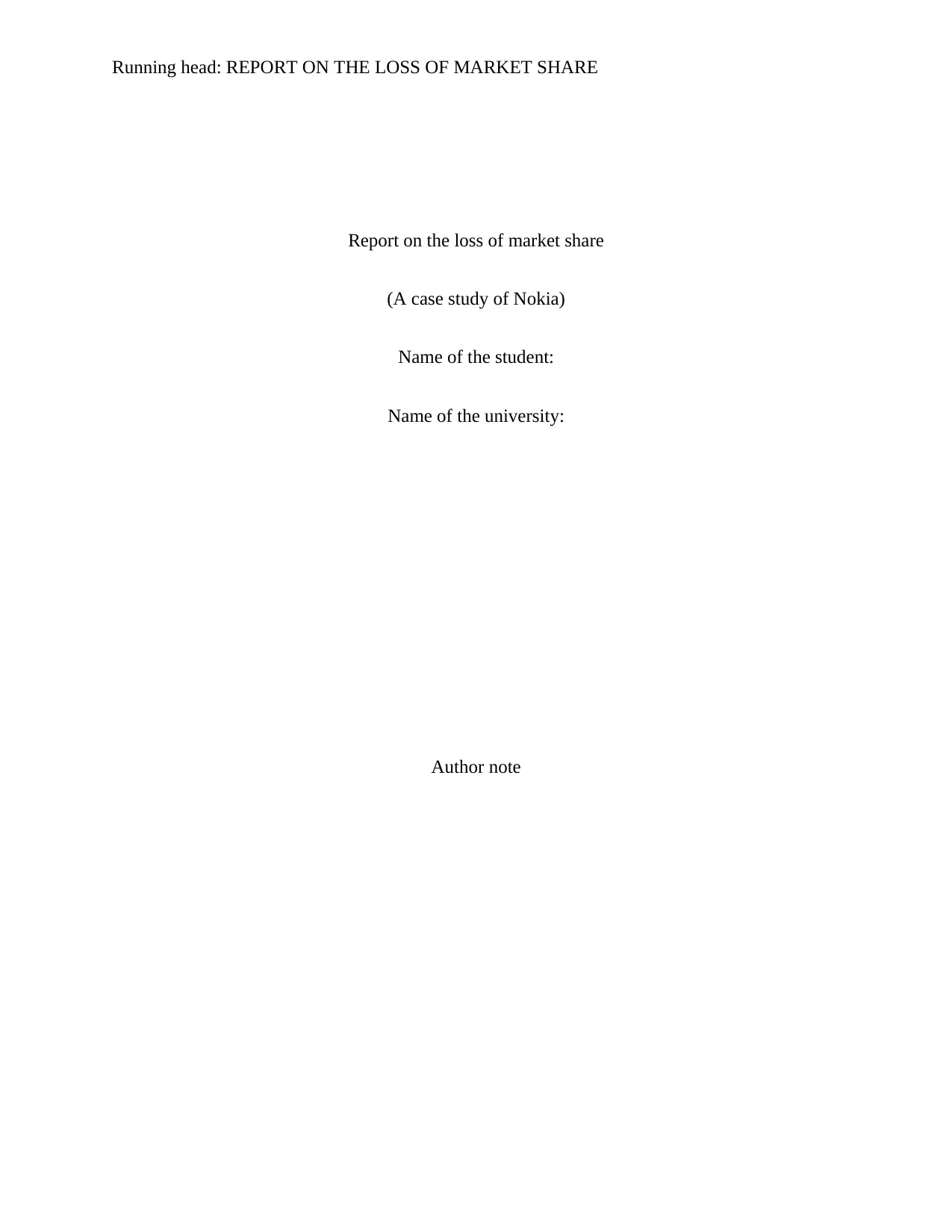
Running head: REPORT ON THE LOSS OF MARKET SHARE
Report on the loss of market share
(A case study of Nokia)
Name of the student:
Name of the university:
Author note
Report on the loss of market share
(A case study of Nokia)
Name of the student:
Name of the university:
Author note
Paraphrase This Document
Need a fresh take? Get an instant paraphrase of this document with our AI Paraphraser
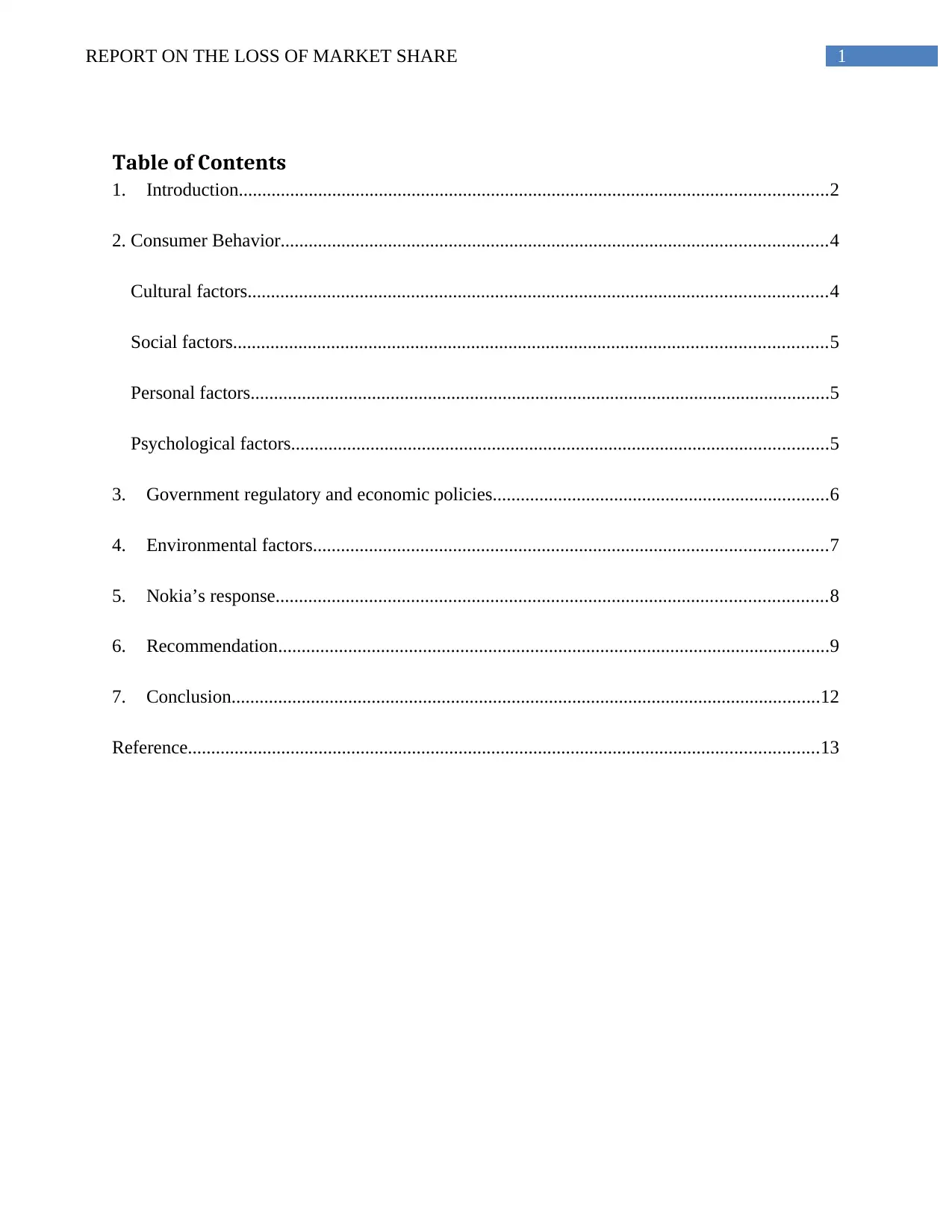
1REPORT ON THE LOSS OF MARKET SHARE
Table of Contents
1. Introduction..............................................................................................................................2
2. Consumer Behavior.....................................................................................................................4
Cultural factors............................................................................................................................4
Social factors...............................................................................................................................5
Personal factors............................................................................................................................5
Psychological factors...................................................................................................................5
3. Government regulatory and economic policies........................................................................6
4. Environmental factors..............................................................................................................7
5. Nokia’s response......................................................................................................................8
6. Recommendation......................................................................................................................9
7. Conclusion..............................................................................................................................12
Reference.......................................................................................................................................13
Table of Contents
1. Introduction..............................................................................................................................2
2. Consumer Behavior.....................................................................................................................4
Cultural factors............................................................................................................................4
Social factors...............................................................................................................................5
Personal factors............................................................................................................................5
Psychological factors...................................................................................................................5
3. Government regulatory and economic policies........................................................................6
4. Environmental factors..............................................................................................................7
5. Nokia’s response......................................................................................................................8
6. Recommendation......................................................................................................................9
7. Conclusion..............................................................................................................................12
Reference.......................................................................................................................................13
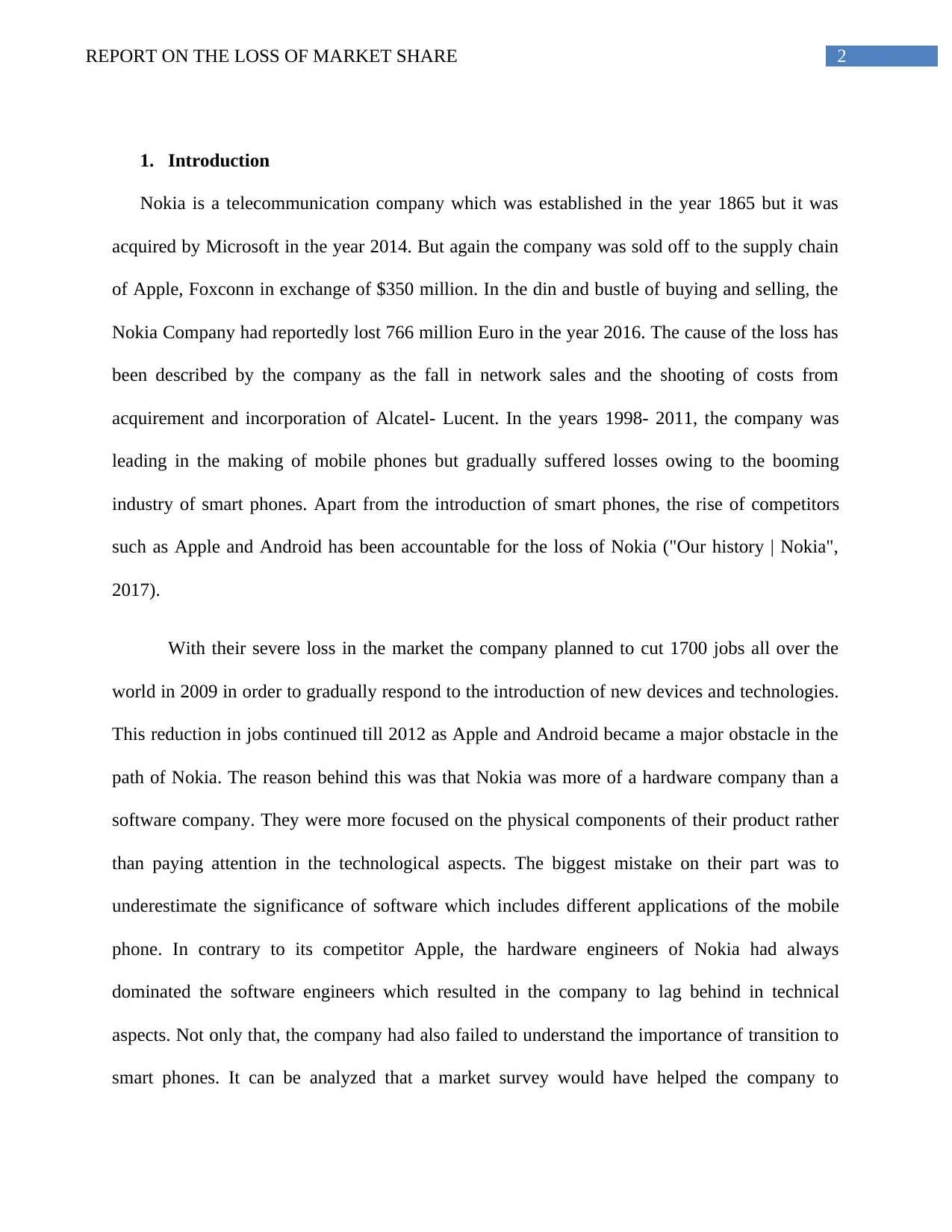
2REPORT ON THE LOSS OF MARKET SHARE
1. Introduction
Nokia is a telecommunication company which was established in the year 1865 but it was
acquired by Microsoft in the year 2014. But again the company was sold off to the supply chain
of Apple, Foxconn in exchange of $350 million. In the din and bustle of buying and selling, the
Nokia Company had reportedly lost 766 million Euro in the year 2016. The cause of the loss has
been described by the company as the fall in network sales and the shooting of costs from
acquirement and incorporation of Alcatel- Lucent. In the years 1998- 2011, the company was
leading in the making of mobile phones but gradually suffered losses owing to the booming
industry of smart phones. Apart from the introduction of smart phones, the rise of competitors
such as Apple and Android has been accountable for the loss of Nokia ("Our history | Nokia",
2017).
With their severe loss in the market the company planned to cut 1700 jobs all over the
world in 2009 in order to gradually respond to the introduction of new devices and technologies.
This reduction in jobs continued till 2012 as Apple and Android became a major obstacle in the
path of Nokia. The reason behind this was that Nokia was more of a hardware company than a
software company. They were more focused on the physical components of their product rather
than paying attention in the technological aspects. The biggest mistake on their part was to
underestimate the significance of software which includes different applications of the mobile
phone. In contrary to its competitor Apple, the hardware engineers of Nokia had always
dominated the software engineers which resulted in the company to lag behind in technical
aspects. Not only that, the company had also failed to understand the importance of transition to
smart phones. It can be analyzed that a market survey would have helped the company to
1. Introduction
Nokia is a telecommunication company which was established in the year 1865 but it was
acquired by Microsoft in the year 2014. But again the company was sold off to the supply chain
of Apple, Foxconn in exchange of $350 million. In the din and bustle of buying and selling, the
Nokia Company had reportedly lost 766 million Euro in the year 2016. The cause of the loss has
been described by the company as the fall in network sales and the shooting of costs from
acquirement and incorporation of Alcatel- Lucent. In the years 1998- 2011, the company was
leading in the making of mobile phones but gradually suffered losses owing to the booming
industry of smart phones. Apart from the introduction of smart phones, the rise of competitors
such as Apple and Android has been accountable for the loss of Nokia ("Our history | Nokia",
2017).
With their severe loss in the market the company planned to cut 1700 jobs all over the
world in 2009 in order to gradually respond to the introduction of new devices and technologies.
This reduction in jobs continued till 2012 as Apple and Android became a major obstacle in the
path of Nokia. The reason behind this was that Nokia was more of a hardware company than a
software company. They were more focused on the physical components of their product rather
than paying attention in the technological aspects. The biggest mistake on their part was to
underestimate the significance of software which includes different applications of the mobile
phone. In contrary to its competitor Apple, the hardware engineers of Nokia had always
dominated the software engineers which resulted in the company to lag behind in technical
aspects. Not only that, the company had also failed to understand the importance of transition to
smart phones. It can be analyzed that a market survey would have helped the company to
⊘ This is a preview!⊘
Do you want full access?
Subscribe today to unlock all pages.

Trusted by 1+ million students worldwide
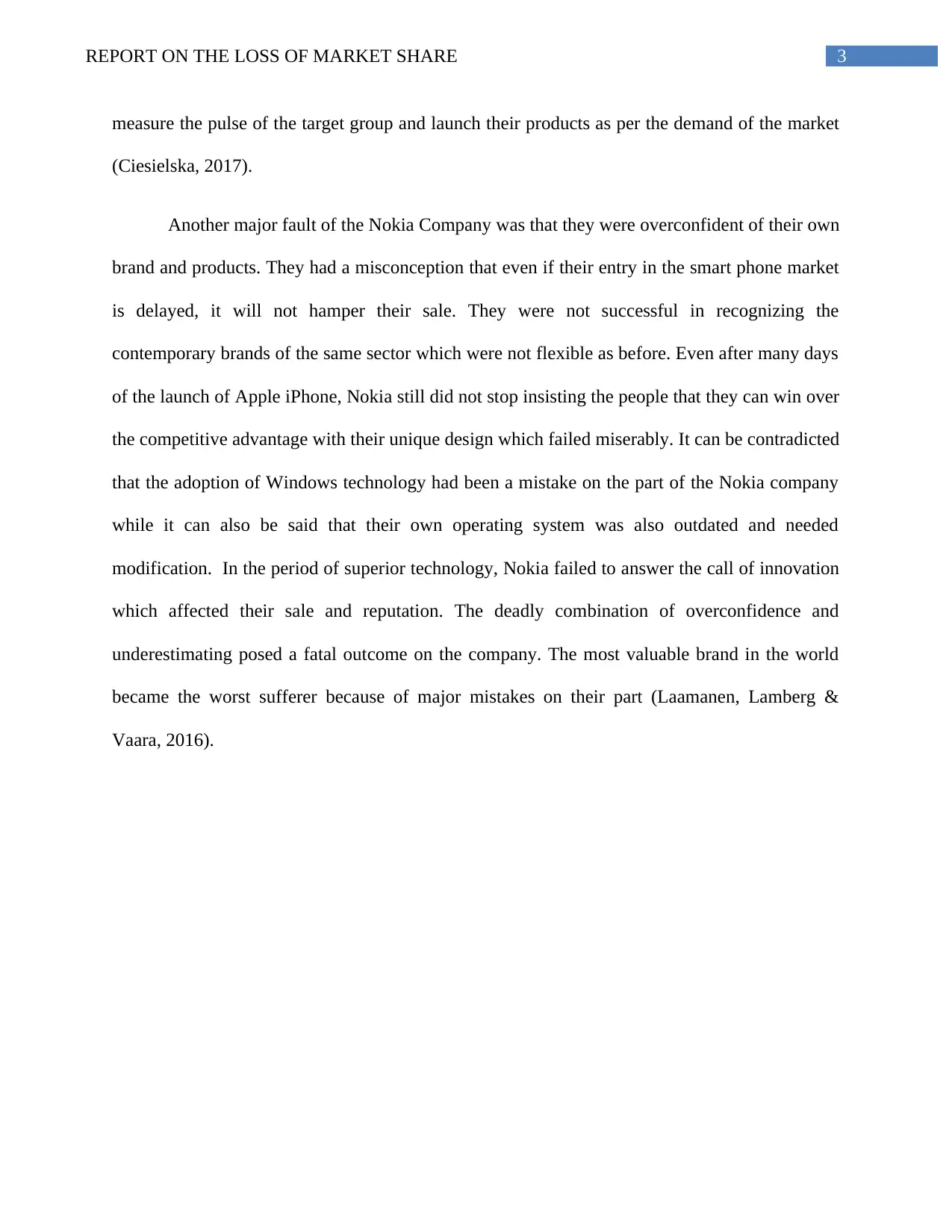
3REPORT ON THE LOSS OF MARKET SHARE
measure the pulse of the target group and launch their products as per the demand of the market
(Ciesielska, 2017).
Another major fault of the Nokia Company was that they were overconfident of their own
brand and products. They had a misconception that even if their entry in the smart phone market
is delayed, it will not hamper their sale. They were not successful in recognizing the
contemporary brands of the same sector which were not flexible as before. Even after many days
of the launch of Apple iPhone, Nokia still did not stop insisting the people that they can win over
the competitive advantage with their unique design which failed miserably. It can be contradicted
that the adoption of Windows technology had been a mistake on the part of the Nokia company
while it can also be said that their own operating system was also outdated and needed
modification. In the period of superior technology, Nokia failed to answer the call of innovation
which affected their sale and reputation. The deadly combination of overconfidence and
underestimating posed a fatal outcome on the company. The most valuable brand in the world
became the worst sufferer because of major mistakes on their part (Laamanen, Lamberg &
Vaara, 2016).
measure the pulse of the target group and launch their products as per the demand of the market
(Ciesielska, 2017).
Another major fault of the Nokia Company was that they were overconfident of their own
brand and products. They had a misconception that even if their entry in the smart phone market
is delayed, it will not hamper their sale. They were not successful in recognizing the
contemporary brands of the same sector which were not flexible as before. Even after many days
of the launch of Apple iPhone, Nokia still did not stop insisting the people that they can win over
the competitive advantage with their unique design which failed miserably. It can be contradicted
that the adoption of Windows technology had been a mistake on the part of the Nokia company
while it can also be said that their own operating system was also outdated and needed
modification. In the period of superior technology, Nokia failed to answer the call of innovation
which affected their sale and reputation. The deadly combination of overconfidence and
underestimating posed a fatal outcome on the company. The most valuable brand in the world
became the worst sufferer because of major mistakes on their part (Laamanen, Lamberg &
Vaara, 2016).
Paraphrase This Document
Need a fresh take? Get an instant paraphrase of this document with our AI Paraphraser
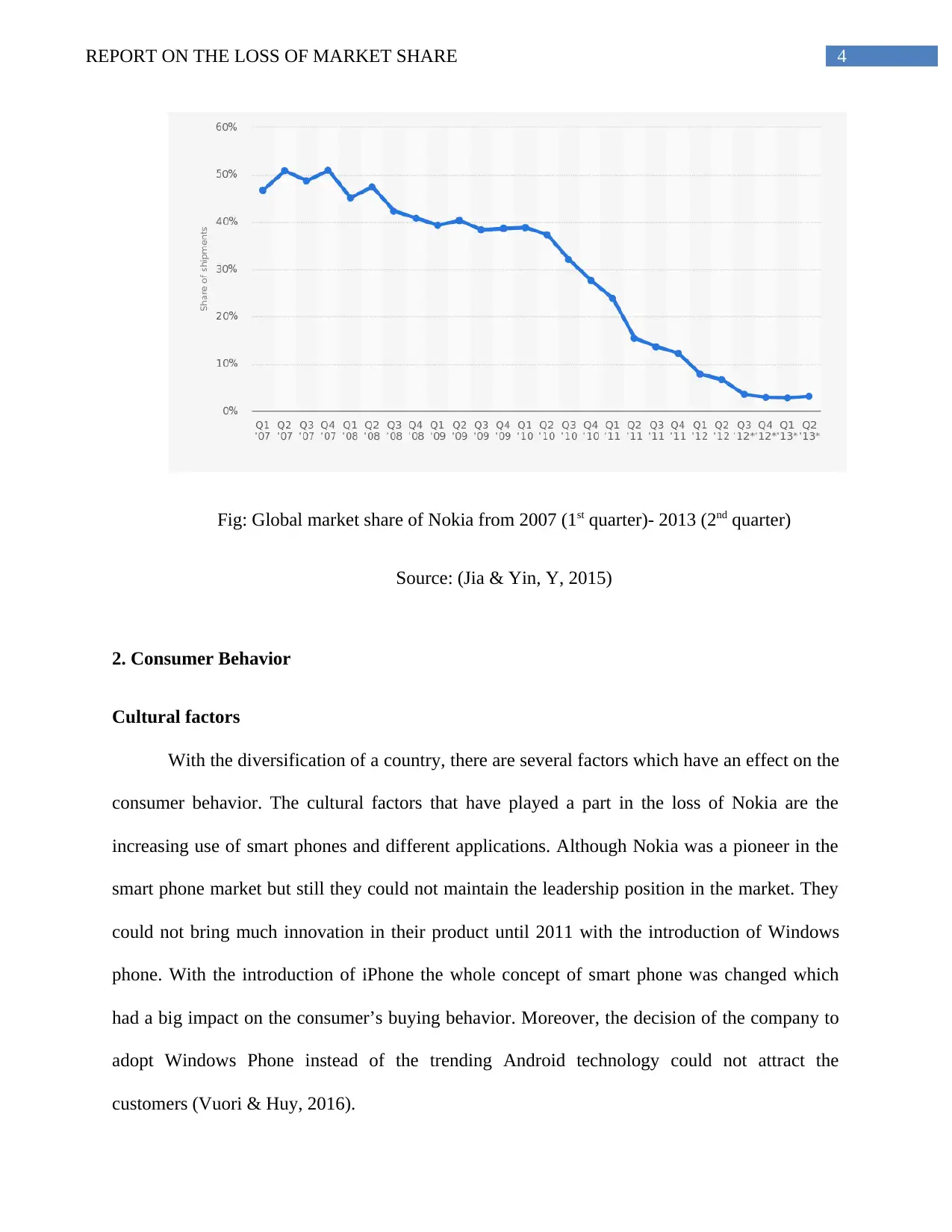
4REPORT ON THE LOSS OF MARKET SHARE
Fig: Global market share of Nokia from 2007 (1st quarter)- 2013 (2nd quarter)
Source: (Jia & Yin, Y, 2015)
2. Consumer Behavior
Cultural factors
With the diversification of a country, there are several factors which have an effect on the
consumer behavior. The cultural factors that have played a part in the loss of Nokia are the
increasing use of smart phones and different applications. Although Nokia was a pioneer in the
smart phone market but still they could not maintain the leadership position in the market. They
could not bring much innovation in their product until 2011 with the introduction of Windows
phone. With the introduction of iPhone the whole concept of smart phone was changed which
had a big impact on the consumer’s buying behavior. Moreover, the decision of the company to
adopt Windows Phone instead of the trending Android technology could not attract the
customers (Vuori & Huy, 2016).
Fig: Global market share of Nokia from 2007 (1st quarter)- 2013 (2nd quarter)
Source: (Jia & Yin, Y, 2015)
2. Consumer Behavior
Cultural factors
With the diversification of a country, there are several factors which have an effect on the
consumer behavior. The cultural factors that have played a part in the loss of Nokia are the
increasing use of smart phones and different applications. Although Nokia was a pioneer in the
smart phone market but still they could not maintain the leadership position in the market. They
could not bring much innovation in their product until 2011 with the introduction of Windows
phone. With the introduction of iPhone the whole concept of smart phone was changed which
had a big impact on the consumer’s buying behavior. Moreover, the decision of the company to
adopt Windows Phone instead of the trending Android technology could not attract the
customers (Vuori & Huy, 2016).
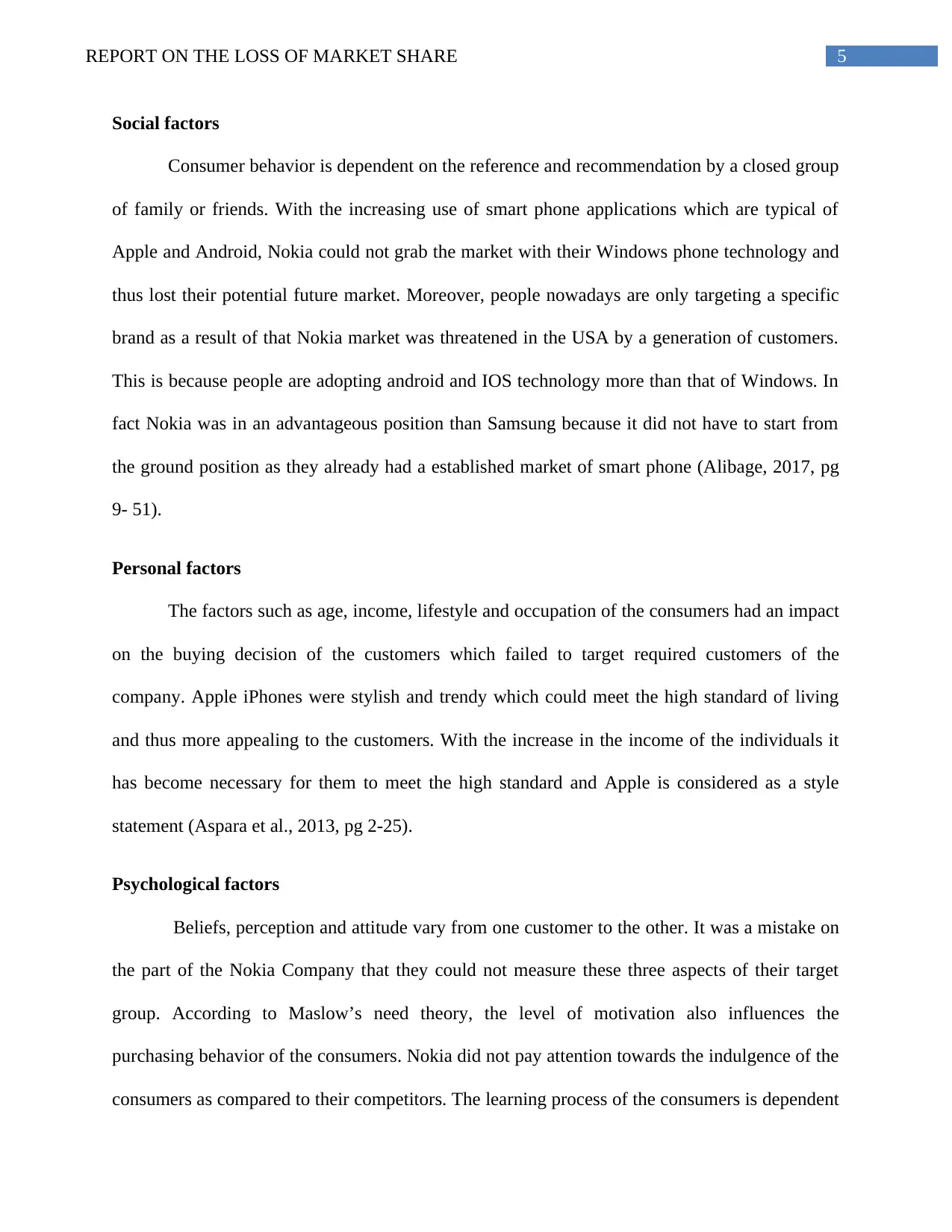
5REPORT ON THE LOSS OF MARKET SHARE
Social factors
Consumer behavior is dependent on the reference and recommendation by a closed group
of family or friends. With the increasing use of smart phone applications which are typical of
Apple and Android, Nokia could not grab the market with their Windows phone technology and
thus lost their potential future market. Moreover, people nowadays are only targeting a specific
brand as a result of that Nokia market was threatened in the USA by a generation of customers.
This is because people are adopting android and IOS technology more than that of Windows. In
fact Nokia was in an advantageous position than Samsung because it did not have to start from
the ground position as they already had a established market of smart phone (Alibage, 2017, pg
9- 51).
Personal factors
The factors such as age, income, lifestyle and occupation of the consumers had an impact
on the buying decision of the customers which failed to target required customers of the
company. Apple iPhones were stylish and trendy which could meet the high standard of living
and thus more appealing to the customers. With the increase in the income of the individuals it
has become necessary for them to meet the high standard and Apple is considered as a style
statement (Aspara et al., 2013, pg 2-25).
Psychological factors
Beliefs, perception and attitude vary from one customer to the other. It was a mistake on
the part of the Nokia Company that they could not measure these three aspects of their target
group. According to Maslow’s need theory, the level of motivation also influences the
purchasing behavior of the consumers. Nokia did not pay attention towards the indulgence of the
consumers as compared to their competitors. The learning process of the consumers is dependent
Social factors
Consumer behavior is dependent on the reference and recommendation by a closed group
of family or friends. With the increasing use of smart phone applications which are typical of
Apple and Android, Nokia could not grab the market with their Windows phone technology and
thus lost their potential future market. Moreover, people nowadays are only targeting a specific
brand as a result of that Nokia market was threatened in the USA by a generation of customers.
This is because people are adopting android and IOS technology more than that of Windows. In
fact Nokia was in an advantageous position than Samsung because it did not have to start from
the ground position as they already had a established market of smart phone (Alibage, 2017, pg
9- 51).
Personal factors
The factors such as age, income, lifestyle and occupation of the consumers had an impact
on the buying decision of the customers which failed to target required customers of the
company. Apple iPhones were stylish and trendy which could meet the high standard of living
and thus more appealing to the customers. With the increase in the income of the individuals it
has become necessary for them to meet the high standard and Apple is considered as a style
statement (Aspara et al., 2013, pg 2-25).
Psychological factors
Beliefs, perception and attitude vary from one customer to the other. It was a mistake on
the part of the Nokia Company that they could not measure these three aspects of their target
group. According to Maslow’s need theory, the level of motivation also influences the
purchasing behavior of the consumers. Nokia did not pay attention towards the indulgence of the
consumers as compared to their competitors. The learning process of the consumers is dependent
⊘ This is a preview!⊘
Do you want full access?
Subscribe today to unlock all pages.

Trusted by 1+ million students worldwide
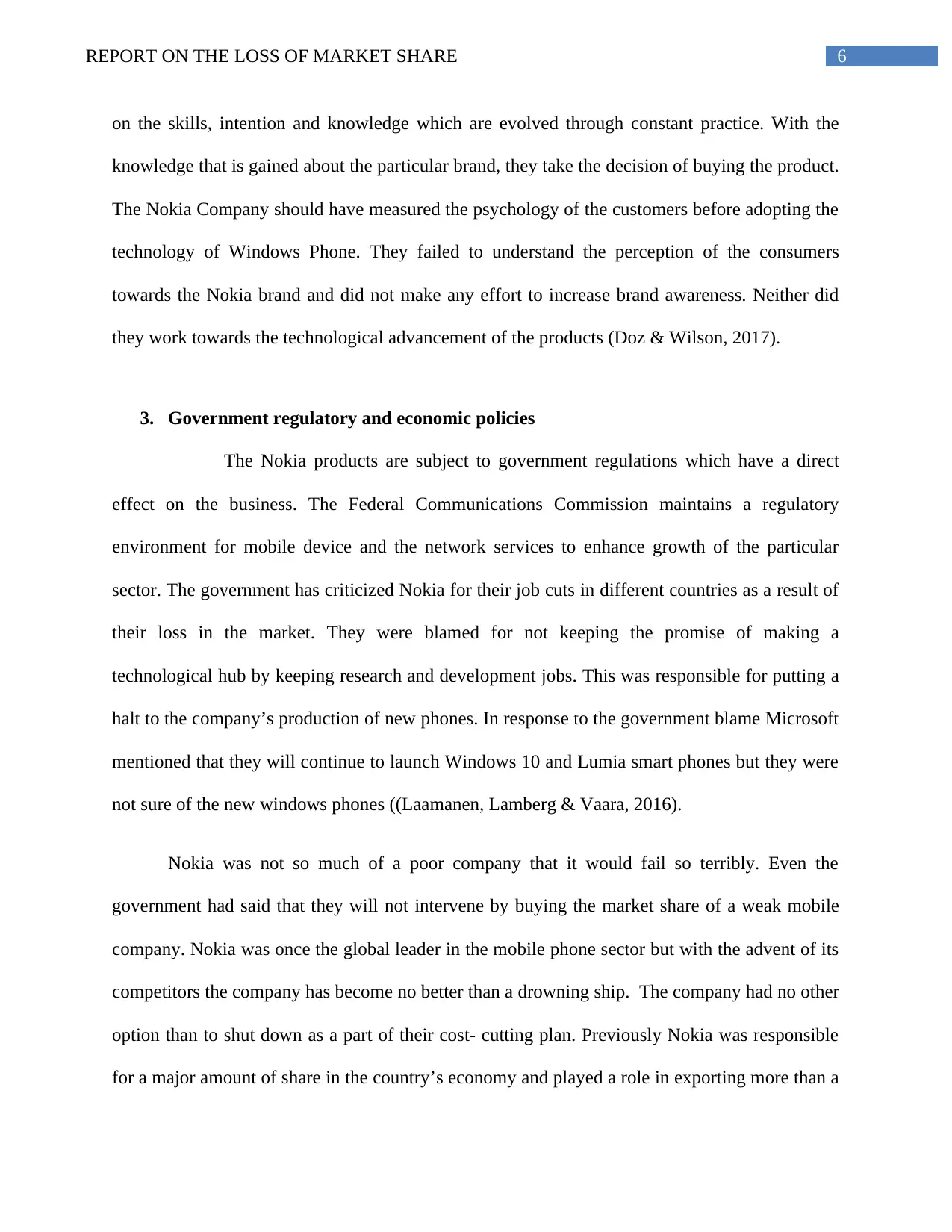
6REPORT ON THE LOSS OF MARKET SHARE
on the skills, intention and knowledge which are evolved through constant practice. With the
knowledge that is gained about the particular brand, they take the decision of buying the product.
The Nokia Company should have measured the psychology of the customers before adopting the
technology of Windows Phone. They failed to understand the perception of the consumers
towards the Nokia brand and did not make any effort to increase brand awareness. Neither did
they work towards the technological advancement of the products (Doz & Wilson, 2017).
3. Government regulatory and economic policies
The Nokia products are subject to government regulations which have a direct
effect on the business. The Federal Communications Commission maintains a regulatory
environment for mobile device and the network services to enhance growth of the particular
sector. The government has criticized Nokia for their job cuts in different countries as a result of
their loss in the market. They were blamed for not keeping the promise of making a
technological hub by keeping research and development jobs. This was responsible for putting a
halt to the company’s production of new phones. In response to the government blame Microsoft
mentioned that they will continue to launch Windows 10 and Lumia smart phones but they were
not sure of the new windows phones ((Laamanen, Lamberg & Vaara, 2016).
Nokia was not so much of a poor company that it would fail so terribly. Even the
government had said that they will not intervene by buying the market share of a weak mobile
company. Nokia was once the global leader in the mobile phone sector but with the advent of its
competitors the company has become no better than a drowning ship. The company had no other
option than to shut down as a part of their cost- cutting plan. Previously Nokia was responsible
for a major amount of share in the country’s economy and played a role in exporting more than a
on the skills, intention and knowledge which are evolved through constant practice. With the
knowledge that is gained about the particular brand, they take the decision of buying the product.
The Nokia Company should have measured the psychology of the customers before adopting the
technology of Windows Phone. They failed to understand the perception of the consumers
towards the Nokia brand and did not make any effort to increase brand awareness. Neither did
they work towards the technological advancement of the products (Doz & Wilson, 2017).
3. Government regulatory and economic policies
The Nokia products are subject to government regulations which have a direct
effect on the business. The Federal Communications Commission maintains a regulatory
environment for mobile device and the network services to enhance growth of the particular
sector. The government has criticized Nokia for their job cuts in different countries as a result of
their loss in the market. They were blamed for not keeping the promise of making a
technological hub by keeping research and development jobs. This was responsible for putting a
halt to the company’s production of new phones. In response to the government blame Microsoft
mentioned that they will continue to launch Windows 10 and Lumia smart phones but they were
not sure of the new windows phones ((Laamanen, Lamberg & Vaara, 2016).
Nokia was not so much of a poor company that it would fail so terribly. Even the
government had said that they will not intervene by buying the market share of a weak mobile
company. Nokia was once the global leader in the mobile phone sector but with the advent of its
competitors the company has become no better than a drowning ship. The company had no other
option than to shut down as a part of their cost- cutting plan. Previously Nokia was responsible
for a major amount of share in the country’s economy and played a role in exporting more than a
Paraphrase This Document
Need a fresh take? Get an instant paraphrase of this document with our AI Paraphraser
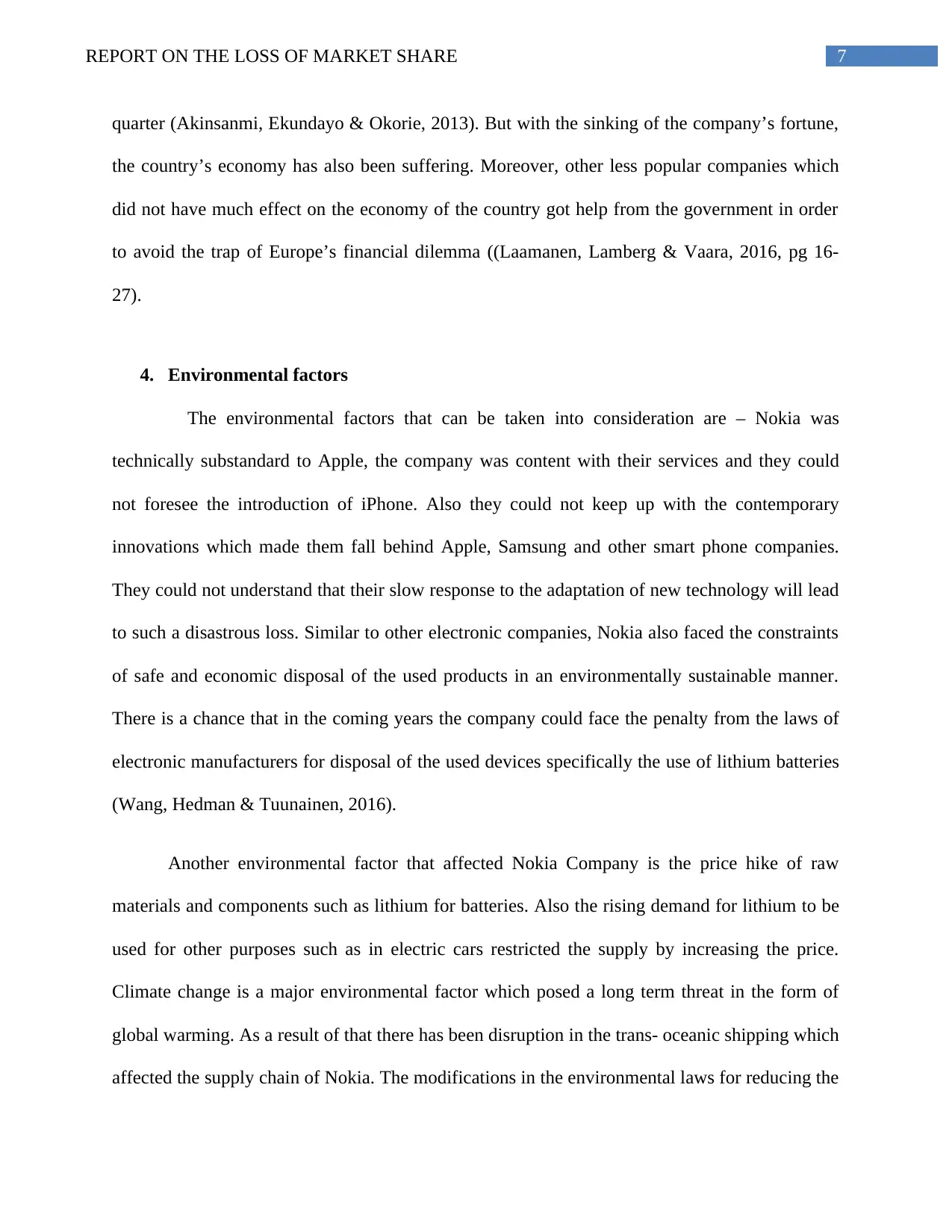
7REPORT ON THE LOSS OF MARKET SHARE
quarter (Akinsanmi, Ekundayo & Okorie, 2013). But with the sinking of the company’s fortune,
the country’s economy has also been suffering. Moreover, other less popular companies which
did not have much effect on the economy of the country got help from the government in order
to avoid the trap of Europe’s financial dilemma ((Laamanen, Lamberg & Vaara, 2016, pg 16-
27).
4. Environmental factors
The environmental factors that can be taken into consideration are – Nokia was
technically substandard to Apple, the company was content with their services and they could
not foresee the introduction of iPhone. Also they could not keep up with the contemporary
innovations which made them fall behind Apple, Samsung and other smart phone companies.
They could not understand that their slow response to the adaptation of new technology will lead
to such a disastrous loss. Similar to other electronic companies, Nokia also faced the constraints
of safe and economic disposal of the used products in an environmentally sustainable manner.
There is a chance that in the coming years the company could face the penalty from the laws of
electronic manufacturers for disposal of the used devices specifically the use of lithium batteries
(Wang, Hedman & Tuunainen, 2016).
Another environmental factor that affected Nokia Company is the price hike of raw
materials and components such as lithium for batteries. Also the rising demand for lithium to be
used for other purposes such as in electric cars restricted the supply by increasing the price.
Climate change is a major environmental factor which posed a long term threat in the form of
global warming. As a result of that there has been disruption in the trans- oceanic shipping which
affected the supply chain of Nokia. The modifications in the environmental laws for reducing the
quarter (Akinsanmi, Ekundayo & Okorie, 2013). But with the sinking of the company’s fortune,
the country’s economy has also been suffering. Moreover, other less popular companies which
did not have much effect on the economy of the country got help from the government in order
to avoid the trap of Europe’s financial dilemma ((Laamanen, Lamberg & Vaara, 2016, pg 16-
27).
4. Environmental factors
The environmental factors that can be taken into consideration are – Nokia was
technically substandard to Apple, the company was content with their services and they could
not foresee the introduction of iPhone. Also they could not keep up with the contemporary
innovations which made them fall behind Apple, Samsung and other smart phone companies.
They could not understand that their slow response to the adaptation of new technology will lead
to such a disastrous loss. Similar to other electronic companies, Nokia also faced the constraints
of safe and economic disposal of the used products in an environmentally sustainable manner.
There is a chance that in the coming years the company could face the penalty from the laws of
electronic manufacturers for disposal of the used devices specifically the use of lithium batteries
(Wang, Hedman & Tuunainen, 2016).
Another environmental factor that affected Nokia Company is the price hike of raw
materials and components such as lithium for batteries. Also the rising demand for lithium to be
used for other purposes such as in electric cars restricted the supply by increasing the price.
Climate change is a major environmental factor which posed a long term threat in the form of
global warming. As a result of that there has been disruption in the trans- oceanic shipping which
affected the supply chain of Nokia. The modifications in the environmental laws for reducing the
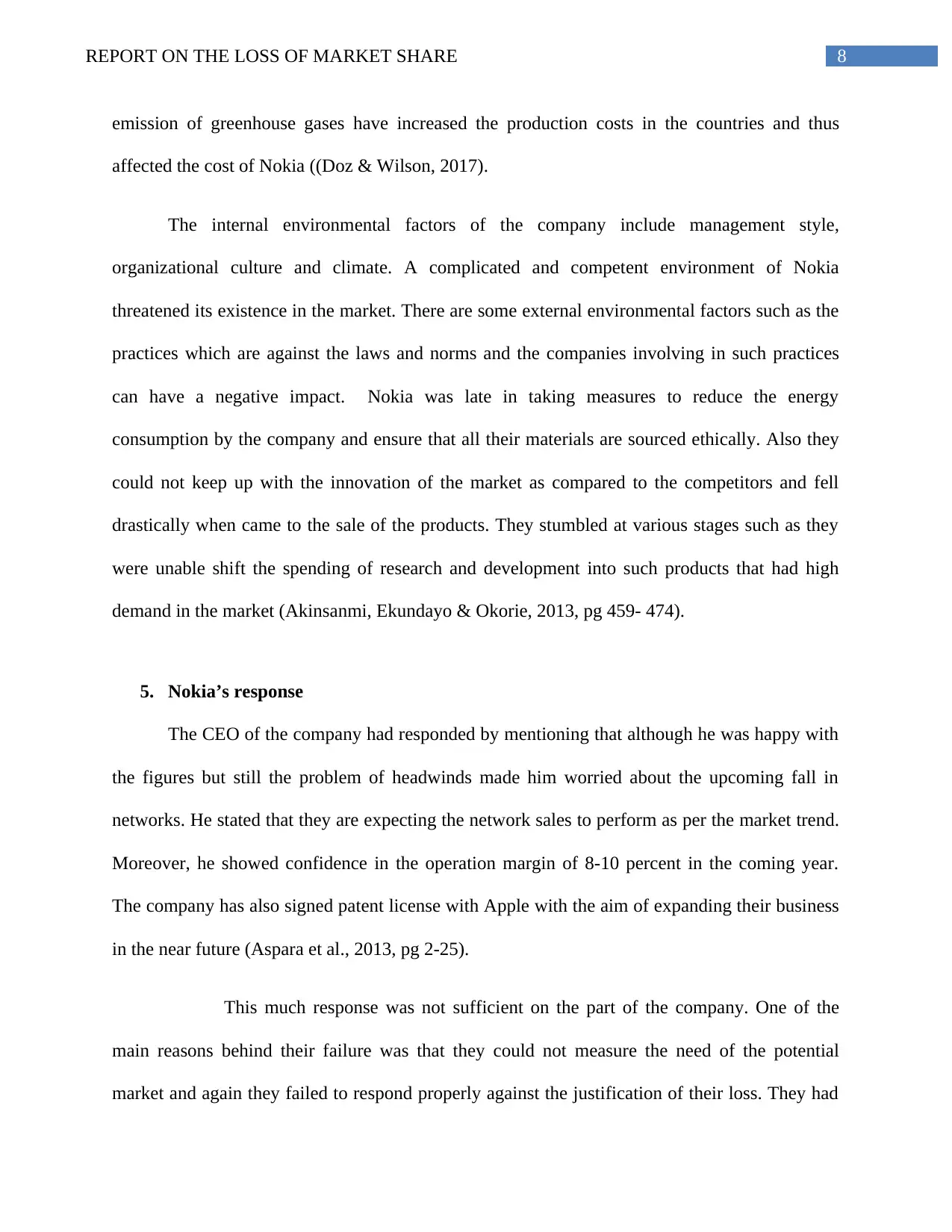
8REPORT ON THE LOSS OF MARKET SHARE
emission of greenhouse gases have increased the production costs in the countries and thus
affected the cost of Nokia ((Doz & Wilson, 2017).
The internal environmental factors of the company include management style,
organizational culture and climate. A complicated and competent environment of Nokia
threatened its existence in the market. There are some external environmental factors such as the
practices which are against the laws and norms and the companies involving in such practices
can have a negative impact. Nokia was late in taking measures to reduce the energy
consumption by the company and ensure that all their materials are sourced ethically. Also they
could not keep up with the innovation of the market as compared to the competitors and fell
drastically when came to the sale of the products. They stumbled at various stages such as they
were unable shift the spending of research and development into such products that had high
demand in the market (Akinsanmi, Ekundayo & Okorie, 2013, pg 459- 474).
5. Nokia’s response
The CEO of the company had responded by mentioning that although he was happy with
the figures but still the problem of headwinds made him worried about the upcoming fall in
networks. He stated that they are expecting the network sales to perform as per the market trend.
Moreover, he showed confidence in the operation margin of 8-10 percent in the coming year.
The company has also signed patent license with Apple with the aim of expanding their business
in the near future (Aspara et al., 2013, pg 2-25).
This much response was not sufficient on the part of the company. One of the
main reasons behind their failure was that they could not measure the need of the potential
market and again they failed to respond properly against the justification of their loss. They had
emission of greenhouse gases have increased the production costs in the countries and thus
affected the cost of Nokia ((Doz & Wilson, 2017).
The internal environmental factors of the company include management style,
organizational culture and climate. A complicated and competent environment of Nokia
threatened its existence in the market. There are some external environmental factors such as the
practices which are against the laws and norms and the companies involving in such practices
can have a negative impact. Nokia was late in taking measures to reduce the energy
consumption by the company and ensure that all their materials are sourced ethically. Also they
could not keep up with the innovation of the market as compared to the competitors and fell
drastically when came to the sale of the products. They stumbled at various stages such as they
were unable shift the spending of research and development into such products that had high
demand in the market (Akinsanmi, Ekundayo & Okorie, 2013, pg 459- 474).
5. Nokia’s response
The CEO of the company had responded by mentioning that although he was happy with
the figures but still the problem of headwinds made him worried about the upcoming fall in
networks. He stated that they are expecting the network sales to perform as per the market trend.
Moreover, he showed confidence in the operation margin of 8-10 percent in the coming year.
The company has also signed patent license with Apple with the aim of expanding their business
in the near future (Aspara et al., 2013, pg 2-25).
This much response was not sufficient on the part of the company. One of the
main reasons behind their failure was that they could not measure the need of the potential
market and again they failed to respond properly against the justification of their loss. They had
⊘ This is a preview!⊘
Do you want full access?
Subscribe today to unlock all pages.

Trusted by 1+ million students worldwide
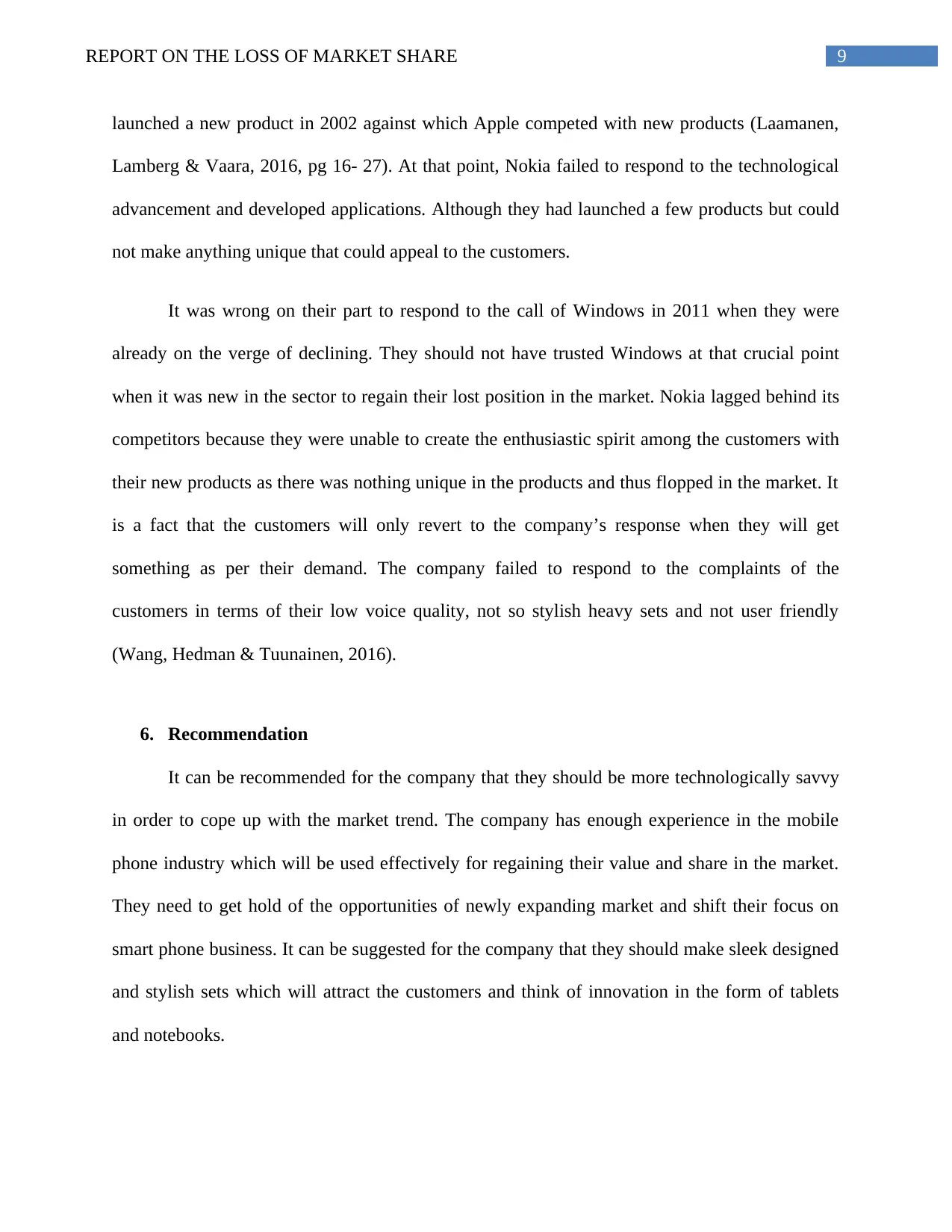
9REPORT ON THE LOSS OF MARKET SHARE
launched a new product in 2002 against which Apple competed with new products (Laamanen,
Lamberg & Vaara, 2016, pg 16- 27). At that point, Nokia failed to respond to the technological
advancement and developed applications. Although they had launched a few products but could
not make anything unique that could appeal to the customers.
It was wrong on their part to respond to the call of Windows in 2011 when they were
already on the verge of declining. They should not have trusted Windows at that crucial point
when it was new in the sector to regain their lost position in the market. Nokia lagged behind its
competitors because they were unable to create the enthusiastic spirit among the customers with
their new products as there was nothing unique in the products and thus flopped in the market. It
is a fact that the customers will only revert to the company’s response when they will get
something as per their demand. The company failed to respond to the complaints of the
customers in terms of their low voice quality, not so stylish heavy sets and not user friendly
(Wang, Hedman & Tuunainen, 2016).
6. Recommendation
It can be recommended for the company that they should be more technologically savvy
in order to cope up with the market trend. The company has enough experience in the mobile
phone industry which will be used effectively for regaining their value and share in the market.
They need to get hold of the opportunities of newly expanding market and shift their focus on
smart phone business. It can be suggested for the company that they should make sleek designed
and stylish sets which will attract the customers and think of innovation in the form of tablets
and notebooks.
launched a new product in 2002 against which Apple competed with new products (Laamanen,
Lamberg & Vaara, 2016, pg 16- 27). At that point, Nokia failed to respond to the technological
advancement and developed applications. Although they had launched a few products but could
not make anything unique that could appeal to the customers.
It was wrong on their part to respond to the call of Windows in 2011 when they were
already on the verge of declining. They should not have trusted Windows at that crucial point
when it was new in the sector to regain their lost position in the market. Nokia lagged behind its
competitors because they were unable to create the enthusiastic spirit among the customers with
their new products as there was nothing unique in the products and thus flopped in the market. It
is a fact that the customers will only revert to the company’s response when they will get
something as per their demand. The company failed to respond to the complaints of the
customers in terms of their low voice quality, not so stylish heavy sets and not user friendly
(Wang, Hedman & Tuunainen, 2016).
6. Recommendation
It can be recommended for the company that they should be more technologically savvy
in order to cope up with the market trend. The company has enough experience in the mobile
phone industry which will be used effectively for regaining their value and share in the market.
They need to get hold of the opportunities of newly expanding market and shift their focus on
smart phone business. It can be suggested for the company that they should make sleek designed
and stylish sets which will attract the customers and think of innovation in the form of tablets
and notebooks.
Paraphrase This Document
Need a fresh take? Get an instant paraphrase of this document with our AI Paraphraser
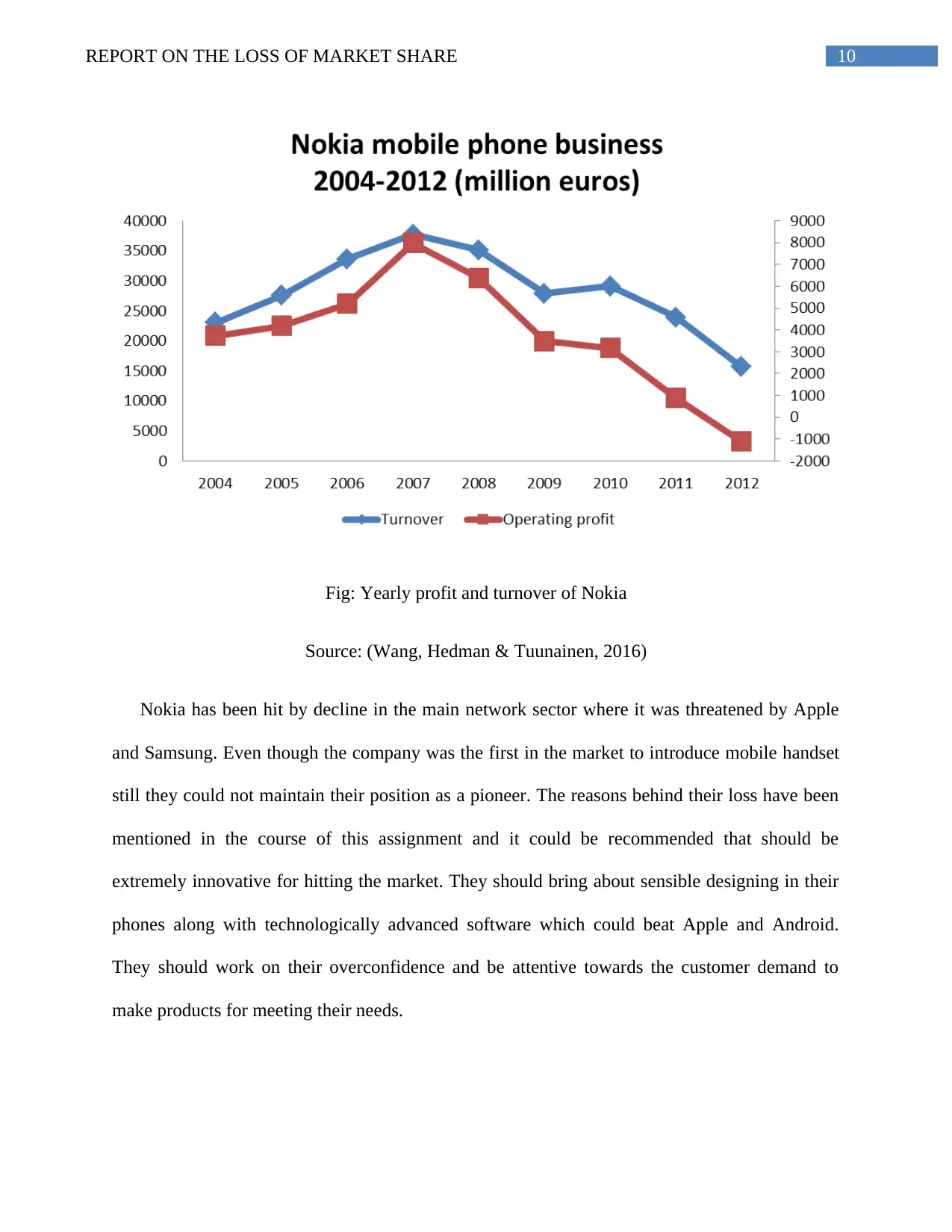
10REPORT ON THE LOSS OF MARKET SHARE
Fig: Yearly profit and turnover of Nokia
Source: (Wang, Hedman & Tuunainen, 2016)
Nokia has been hit by decline in the main network sector where it was threatened by Apple
and Samsung. Even though the company was the first in the market to introduce mobile handset
still they could not maintain their position as a pioneer. The reasons behind their loss have been
mentioned in the course of this assignment and it could be recommended that should be
extremely innovative for hitting the market. They should bring about sensible designing in their
phones along with technologically advanced software which could beat Apple and Android.
They should work on their overconfidence and be attentive towards the customer demand to
make products for meeting their needs.
Fig: Yearly profit and turnover of Nokia
Source: (Wang, Hedman & Tuunainen, 2016)
Nokia has been hit by decline in the main network sector where it was threatened by Apple
and Samsung. Even though the company was the first in the market to introduce mobile handset
still they could not maintain their position as a pioneer. The reasons behind their loss have been
mentioned in the course of this assignment and it could be recommended that should be
extremely innovative for hitting the market. They should bring about sensible designing in their
phones along with technologically advanced software which could beat Apple and Android.
They should work on their overconfidence and be attentive towards the customer demand to
make products for meeting their needs.
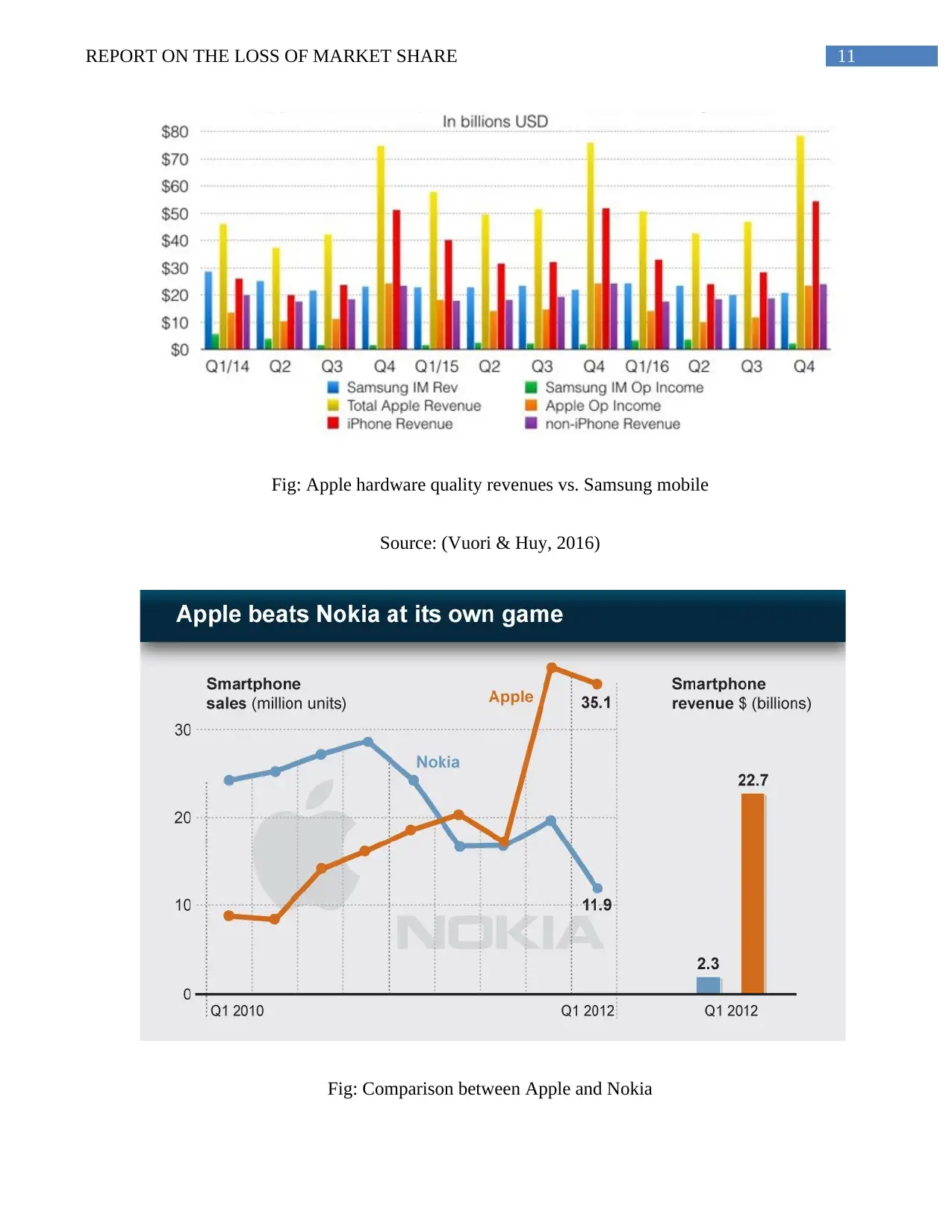
11REPORT ON THE LOSS OF MARKET SHARE
Fig: Apple hardware quality revenues vs. Samsung mobile
Source: (Vuori & Huy, 2016)
Fig: Comparison between Apple and Nokia
Fig: Apple hardware quality revenues vs. Samsung mobile
Source: (Vuori & Huy, 2016)
Fig: Comparison between Apple and Nokia
⊘ This is a preview!⊘
Do you want full access?
Subscribe today to unlock all pages.

Trusted by 1+ million students worldwide
1 out of 15
Related Documents
Your All-in-One AI-Powered Toolkit for Academic Success.
+13062052269
info@desklib.com
Available 24*7 on WhatsApp / Email
![[object Object]](/_next/static/media/star-bottom.7253800d.svg)
Unlock your academic potential
Copyright © 2020–2025 A2Z Services. All Rights Reserved. Developed and managed by ZUCOL.




